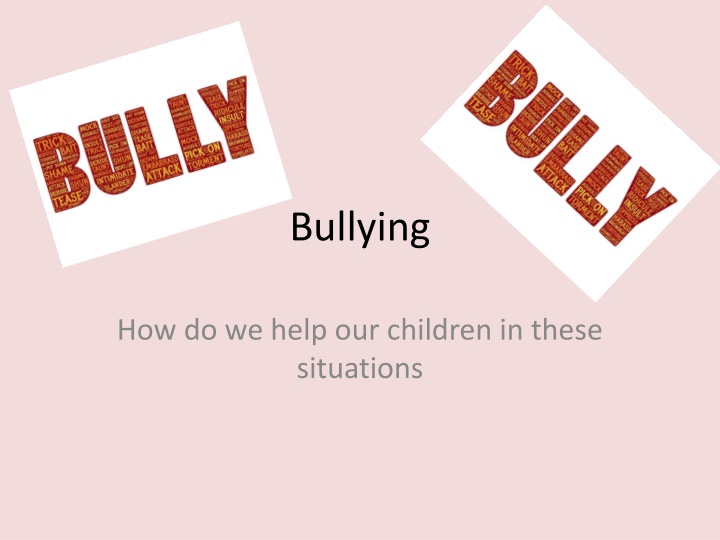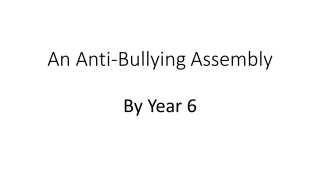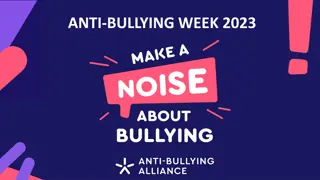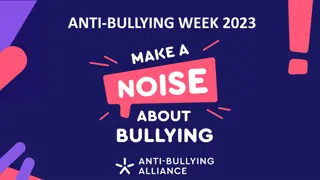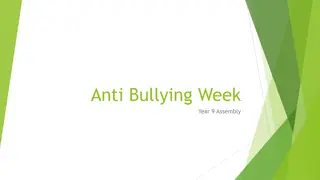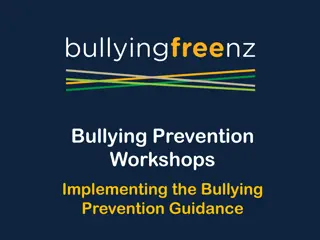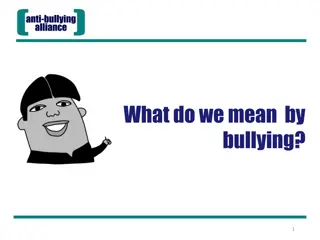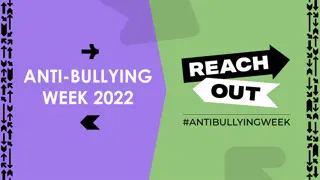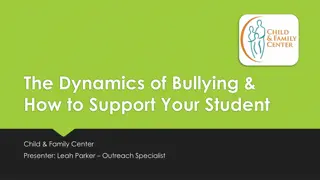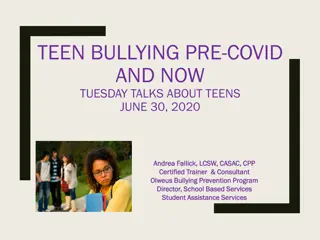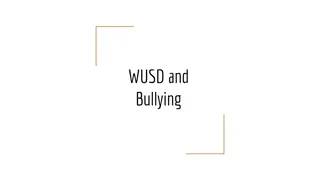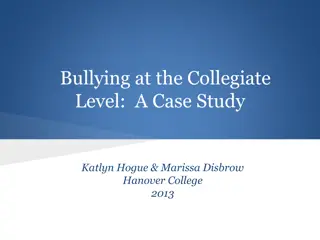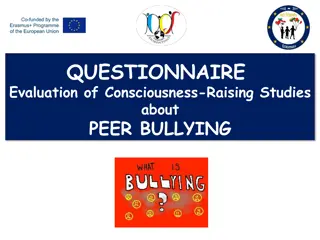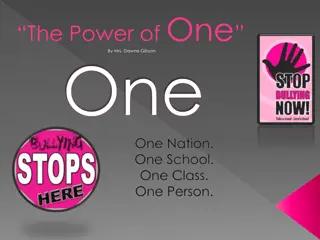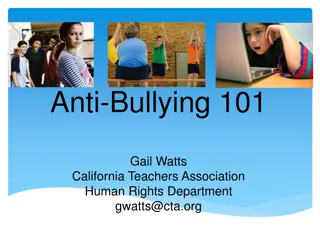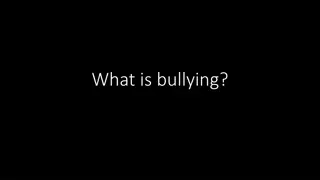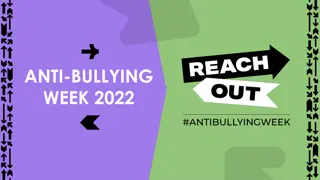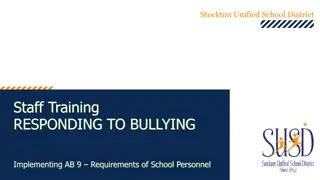Helping Children Deal with Bullying: Tips and Support
Empowering children to navigate and overcome bullying situations is essential for their well-being. Discover effective strategies, resources, and advice to help support your child through these challenges.
Download Presentation

Please find below an Image/Link to download the presentation.
The content on the website is provided AS IS for your information and personal use only. It may not be sold, licensed, or shared on other websites without obtaining consent from the author.If you encounter any issues during the download, it is possible that the publisher has removed the file from their server.
You are allowed to download the files provided on this website for personal or commercial use, subject to the condition that they are used lawfully. All files are the property of their respective owners.
The content on the website is provided AS IS for your information and personal use only. It may not be sold, licensed, or shared on other websites without obtaining consent from the author.
E N D
Presentation Transcript
Bullying How do we help our children in these situations
What is Bullying Bullying is unwanted, aggressive behaviour among school aged children that involves a real or perceived power imbalance. The behaviour is repeated, or has the potential to be repeated, over time. Both kids who are bullied and who bully others may have serious, lasting problems.
Tricks to help Field describes four types of bullying: 1. Teasing Teasing is verbal violence and the most dangerous and long-lasting form of bullying. 2. Exclusion Exclusion or relational bullying is based on social manipulation, and can be expressed openly You can t sit with us as well as involving indirect, subtle, secret behaviours or non verbal language by the bully and others. 3. Physical Physical bullying involves regularly attacking someone who is weaker. 4. Harrassment
Types of Bullying It can be covert or cyber-based (happening online through social networks or even through mobile phones). Bullying can be physical or emotional. According to the National Centre Against Bullying, there are five different kinds of bullying behaviour. They are: 1. Physical bullying: when physical actions such as hitting, poking, tripping or pushing, are used to hurt and intimidate. Repeatedly and intentionally damaging someone s belongings is also physical bullying, says the centre. 2. Verbal bullying: involves the use of negative words, like name calling, insults, homophobic or racist slurs, or words used to intentionally upset someone. 3. Social bullying: when lies, the spreading of rumours or nasty pranks are used. This includes repeated mimicking and deliberate exclusion.
Types of bullying 4. Psychological bullying: involves the repeated and intentional use of words or actions which can cause psychological harm. Examples include intimidation, manipulation and stalking. 5. Cyber bullying: this is the big one at the moment and is when technology is used to verbally, socially or psychologically bully. It can occur in chat rooms, on social networking sites, through emails or on mobile phones. Bullying isn t mutual arguments and disagreements single episodes of social rejection or dislike single-episode acts of nastiness or spite random acts of aggression or intimidation.
Tricks to help with handling a bully Percent of children bullied frequently who stay away from school: about 20%. Those who considered staying away from school: about 50% Percent of children bullied weekly who do not tell their friends: Boys: 40% Girls: 25% The report states that this research indicates bullying is at a relatively high level by world standards. The incidence is higher among primary school students of both sexes; however, boys report being bullied more frequently overall, especially in secondary schools. Bully Blocking, by Evelyn M. Field, is a much praised book that helps parents support their children by explaining the six secrets to help children deal with teasing and bullying. Field explains that we must offer our children more than just the sound instruction, If you are nice to people, they will be nice to you . That is certainly an important lesson but not all children know how to be nice. And not all children, or parents, understand exactly what bullying is: 1.Bullying involves psychological, emotional, social or physical abuse 2.The crucial feature is perception: the target feels powerless 3.The critical issue is the extent of the damage done to the target 4.A bully may or may not intend to hurt.
Tricks to help with handling a bully Harassment generally involves repeated annoying questions, statements or attacks about sexual gender, racial, religious or nationality issue. As the parent, you need to help your child to understand the signs of bullying; ask him or her to describe the bullying experiences and then help your child to develop strategies to avoid the bullying game or behaviour. Field s six secrets to help kids deal with bullying and teasing are: 1. Regulate your feelings 2. Understand why you are bullied or a bully 3. Build your self esteem 4. Become a confident communicator 5. Create your own power pack 6. Develop a support network.
Helping when your child is bullied Discuss with him why he thinks he s being picked on by working out what is making him a target; he can work on strategies to overcome the problem. Make sure he knows that you don t think he s being bullied because of anything he s done. Don t take any action yourself unless your child agrees although if he s being physically hurt, you may have to do something whether he wants you to or not. Help him work on some coping strategies what he can do or say that may help his situation. Don t label your child or offer reasons that he may be being bullied he needs your support not more proof of his lack of worth.
Helping when your child is Bullied Encourage him to ignore any name-calling if he s the type of child who cries easily, try to make him understand that name-calling can t hurt him if he doesn t let it. He may get strength by visualising an invisible wall around him that will protect him from sharp words. Indulge him if he wants to take a new route to school to avoid a bully if, by doing this, he can deal with the bully and feel safe, then you should support him. Contact your child s school, if the bullying is happening there. They should have a bully policy and be receptive to your concerns. If you suspect that it s your child s lack of confidence that is making him a target, encourage his self-confidence by focussing on the things he does well.
Is your child the bully? If your child often tries to explain away misdeeds with 'We were just having fun ', 'She started it ', 'He made me ', 'What? I didn't do anything ' you may just have a bully in the making living under your roof. You must act promptly to nip this behaviour in the bud and make your child understand very clearly that his behaviour is unacceptable and that you won't tolerate it. You need to teach your child to manage and articulate his feelings in ways that don't hurt other people. You will also have to help him 'unlearn' bad habits - teach him other ways of behaving. If your child is a bully, take a look at her home life and consider: The way you discipline your child - are you using bullying tactics yourself? The way you deal with conflict. Have you taught her effective problem-solving skills? The ways you communicate with your child. Are you positive or negative? Whether your child is anxious or frightened about her home life. The types and amount of TV/ games/ computer time she is experiencing? Is she being exposed to inappropriate or violent material?
What makes a bully? Children who bully want to have control over some aspect of their lives even if it s just making someone s life miserable. Kids usually begin bullying to compensate for something that they re lacking in their own lives. They often perform poorly at school and struggle to make strong and lasting friendships. Bullies often: Enjoy picking on kids who are younger or smaller than the rest of the kids Love to pick on new kids to the school as they re new, they don t yet have a group of friends who can back them up Talk loudly and over the top of other people, so no-one else gets to voice their opinion Tell lies about their victim Use blackmail Try to get their victim ignored and excluded from activities Freeze out their victim, so no-one will talk to her Needle their victim with constant name-calling and teasing Steal, withhold or lose their victims possessions
What you need to know about Bullies Bullies rely on those around them their victims, the witnesses, their gang being sufficiently intimidated to be unwilling to do anything to stop their reign of terror. Bullies usually lack self-confidence themselves by engaging in bullying, they make themselves feel better by tormenting those around them and making them feel worse. They choose easy targets because this allows them to avoid looking foolish. Experts think that many bullies have learned this behaviour as a result of being bullied themselves. Some children, who feel at risk of being bullied themselves, join a bully s gang to avoid becoming a target of the bully. Bullies tend to move in a gang they usually have a couple of sidekicks to support them in their bullying behaviour they very rarely operate alone as there s strength in numbers and they love to have an appreciative audience
Is your child being bullied? Even now, with all the publicity about bullying and the zero tolerance attitude of schools, many children who are bullied suffer in silence in fact some research suggests that 20% of targeted children say nothing. Maybe they are too ashamed, or more likely feel too threatened by the bullies to tell anyone. Parents and teachers need to know how to spot whether bullying may be occurring. Children often find it hard to communicate what s going on if they re being bullied. Here s how to spot the signs that your child may be a bullying victim: Physical injuries like unexplained bruises and scratches. A general unhappiness. Reluctance to go to school (often accompanied by vague excuses to stay home). Acdecline in academic performance. Moodiness, withdrawal, tension and tears after school. Talk of hating school and having no friends. Torn clothing. Refusal to discuss what s happening at school. Bed wetting, altered sleep patterns or having nightmares. Changes in eating habits (such as loss of appetite or overeating). Major changes in relationships and friendships with others. Having no friends to share time with Getting into trouble more often, and acting out. Obviously these signs can also point to many other issues. So how do you find out if bullying is the reason for your child s changes in behaviour? You need to talk to your child and try to encourage them to open up about what s happening. Sources include Bullying No Way, National Centre Against Bullying, Raising Children Network, and Bullying Hurts.
How to deal with Bullying? Many children will need some help from their parents to open up and talk about any bullying or issues. For expert tips on broaching the bullying subject with your child, read on? Many kids who are being bullied (one in five, suggests research) will not voluntarily talk to their carers or teachers about what s happening. They will need some coaxing and to feel they are safe to reveal what they re going through. Try these tips when broaching the subject of bullying with your child: Take time to genuinely listen to what s happening, making it clear they are not to blame. Acknowledge and show you understand their negative and painful feelings, taking care not to be dismissive.
How to deal with Bullying? Offer comfort, empathy and support. You will also likely feel anger or sadness about the situation try not to show these feelings, instead staying strong in front of your child, being careful not to over-react or under-react. Resist the temptation to rush out in anger to immediately try to solve the problem. Many children actually believe what the bully says about them or somehow believe they deserve it. Talk to them about the situation and tell them that there is never an excuse for bullying, that no one deserves it. Talk to your child about a plan of action for example, talking to the school and seeking solutions. This article was written by Fiona Baker, former editor in chief of Mother & Baby, Pregnancy & Birth and Wondertime magazines, for Kidspot, Australia s leading parenting and pregnancy resource. Sources include Bullying No Way, National Centre Against Bullying, Raising Children Network, and Bullying Hurts.
What parents can do to help. Bullying do s Rationally collect and confirm the facts with your child. If it s at the school, report it and work with the school to fix the problem. Most schools have tried-and-tested policies and strategies to deal with bullying. Discuss with your child ways to deal with the bully, encouraging them to walk away, keep away and speak to the teacher. Try to stay calm. Bullying don ts Don t take matters into your own hands or act irrationally and impulsively. Never encourage a child to fight back. Don t try to fix the problem by talking with the other children or parents. Don t allow bullying to take place in your own home.
When your child is the bully, here's what to do If it's your child who's the bully, chances are you'll find out through a teacher or fellow parent. It can be shattering as a parent to hear something like this about your child, but it's vital that you act rationally and immediately because while the victims of bullying can grow up to have lifelong issues, so can the perpetrators. Here's a step-by-step guide to trying to stop your child bullying others. Ask your child if they can explain what has happened and why, without you becoming too judgemental at this stage. Talking with your child find out if there are ways you can work together to stop this behaviour. Explain that the bullying behaviour is completely unacceptable and that this situation will worsen if the bullying continues. See if you can get your child to understand how frightened and upset the victim feels. Criticise the behaviour but don't reject your child.
When your child is the Bully here is what to do.. Praise your child's good behaviour. Tell your child that you're confident that he or she can change their behaviour because you know that that you child is not really a bully, and you know is capable of kindness and empathy. If your child is bullying in a gang' help them to develop new interests and encourage friendships away from that group. Observe your child's social skills and ability to get along with others and help them improve these. Spend more time with your child, listening to them, and giving more attention. Support the measures that the organizations (like the school) take to stop the bullying. Reinforce measures at home, explaining that there will be consequences (such as loss of privileges) if the bullying does not stop. According to research, children who are bullies are at risk of developing long-term problems with antisocial behaviour and have a higher risk of engaging in workplace harassment, child abuse, sexual harassment and substance abuse in later life. Some statistics suggest that even half of kids who bully have been bullied themselves.
How to talk about Bullying and Cyber Bullying Here are some tips on how to have a dinner table conversation with your children about bullying. Discussing bullying with your child can help them better understand the issue. And kids love it when their parents engage them in grown-up conversations. While the conversation about bullying is happening in schools nationwide, it also needs to take place at home. A family conversation about bullying can open up this topic for parents and children in which they can discuss what s acceptable and what s not, Dr Toni Noble, a member of the National Centre Against Bullying, says. It will show children that their parents get it and sets in place family values in which bullying is declared unacceptable. Talking to your kids about bullying whether they have been exposed or not helps them understand what behaviour is acceptable.
How to talk about Bullying and Cyber Bullying Bullying is totally unacceptable it is not to be tolerated and it is serious misbehaviour. Swift action must be taken. Discuss what your child should do (i.e. tell you, tell their teacher) It is everyone s problem if someone is being bullied, it can upset everyone. Most children don t like seeing others being bullied. Ask how your child would feel if they saw someone being bullied, let alone being bullied themselves. Independent thinking encourage your child to think for themselves, not to copy the bad and unacceptable behaviours of others. If someone gets bullied, it s not his or her fault stress this point to your child: Nobody deserves to be bullied ever! Everyone has the right to feel sale from being bullied.
How to talk about Bullying and Cyber Bullying What if it happens to them? discuss what steps your child should take ensuring they know they can talk to you. What would you do as a parent make sure they know how you would deal with it, making sure they know your response would be rational. How would they like you to respond? Asking for help is NOT dobbing your child needs to know that asking you or a teacher for help is not trying to get someone into trouble but trying to fix a serious problem. It s important to take action reiterate that bullying is serious and that a grown-up such as a parent or teacher must be told if it is taking place. Be a friend to someone who s being bullied encourage your child to empathise with someone else who may be being bullied. Maybe your child and their friends can make an effort to include them. Discuss with them how even one person doing something small can make a difference
How to tackle Cyber Bullies How to tackle cyber bullies One in 10 kids experience cyber bullying, and that number is on the rise. What can parents do to stop or prevent this? With more and more social networking happening online, it's understandable how the incidence of cyber-bullying has increased. But it's not acceptable, and parents need to play a large role in preventing and combating this form of bullying. Cyber bullying can be conducted through online social networking sites like Facebook or MySpace, in chat rooms, via email and on SMS on mobile phones. About 10% of students say they have been bullied online or through their mobile phones. Of them more than 90% say that this cyber aspect was part of an overall bullying campaign which included face-to-face bullying. Dr Toni Noble, who is working on a revised National Safe Schools Framework for the Federal Government to include cyber bullying, says it's important to keep perspective and realise that this is another form of bullying, not a new fad with a nifty name Cyber bullying is just as devastating for those being targeted - and just as unacceptable, she says. And it's an area where parents must remain vigilant." Here are some tips on how parents can help with this growing problem of cyber bullying.
How to tackle Cyber Bullies Be cyber savvy Learn everything you can about information and communication technologies and how your child is using them. Talk to them about the places and sites they go online and the activities that they are involved in. Encourage communication Provide an environment in which your child will come to you if anybody says or does something that makes them feel uncomfortable or threatened online or via mobile phone. Stay calm. If you freak out they won't turn to you for help when they need it. Watch for signs that your child is being bullied online These could include a reluctance to use the computer or go to school. Take action If the bullying is coming from a student at the same school, meet with school officials and ask for help in resolving the situation. Talk to them about responsible computer and mobile phone use Teach them to never post or say anything that they wouldn't want the whole world - including you - to see or read. Monitor your child's computer use and have their log-ins To keep children safe parents need to have access to email, private messaging and social networking accounts children hold. It's not invading their privacy
How parents can prevent Bullying. How often do we hear that behaviour starts at home. In the case of bullying and society s attitudes to it, these often stem from the home environment. So the parental role in preventing and reducing bullying is vital. Some of the actions parents can take, whether bullying has impacted on you or your child s life or not, are: Explain bullying Tell your children regularly much you disapprove of bullying and why. Tell them you don t want them to take part in mistreating another student at any level, however small. Students who come from families that oppose bullying accept that bullying is wrong and are less likely to bully others because they know their parents would disapprove. Forbid bullying
How parents can prevent Bullying. Do not allow any type of bullying at home and deal firmly with any attempts by siblings to bully one another. Encourage positivity Encourage your child to see the positive side of other students rather than expressing contempt and superiority. Model and encourage respect Model and encourage respect for others as well as behaviours and values, such as compassion, cooperation, friendliness, acceptance of difference and respect. Explain rights of others Emphasise seeing things from another s point of view and the rights of others not to be mistreated. Report incidents
How parents can prevent Bullying. Report all incidents of bullying that you are aware of, not just incidents that happen to your child. Don t continue any child s silent nightmare by saying nothing. Encourage resilience Develop protective behaviours and resilient social skills in your child, such as speaking assertively, negotiating, expressing their own opinion, using a confident voice and using firm eye contact. Practice regularly using dinner conversations and social encounters with acquaintances and new people. Respect and confidence are key Talk about respect and help children distinguish between people who care about their wellbeing and those who don t. Children require the confidence and skills to avoid people who don t treat them with respect. Help build friendships Help your child build and maintain caring and genuine friendships. This may mean taking an active role in encouraging social activities such as after school plays and sleepovers. Deal with fear and anger Assist them to develop effective ways of dealing with fear and anger instead of internalising their feelings, taking them out on others or losing face in front of the peer group by allowing them to spill over.
KLPS Anti Bullying policy T:\Teacher\@Policies
